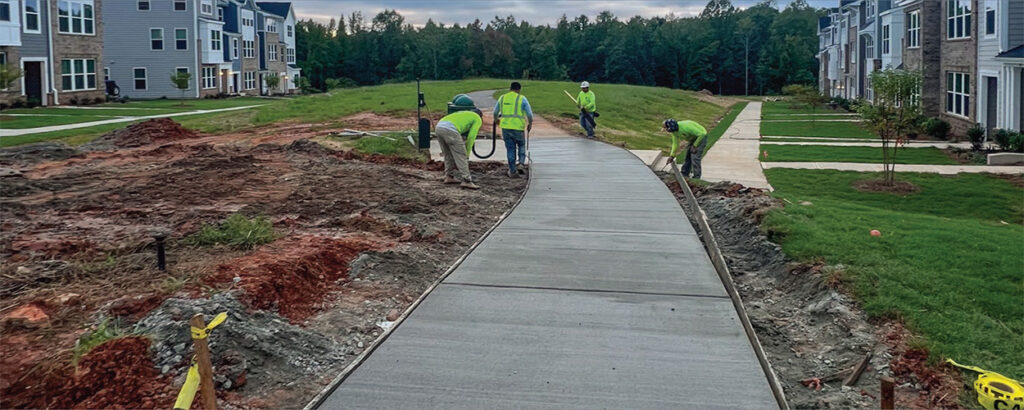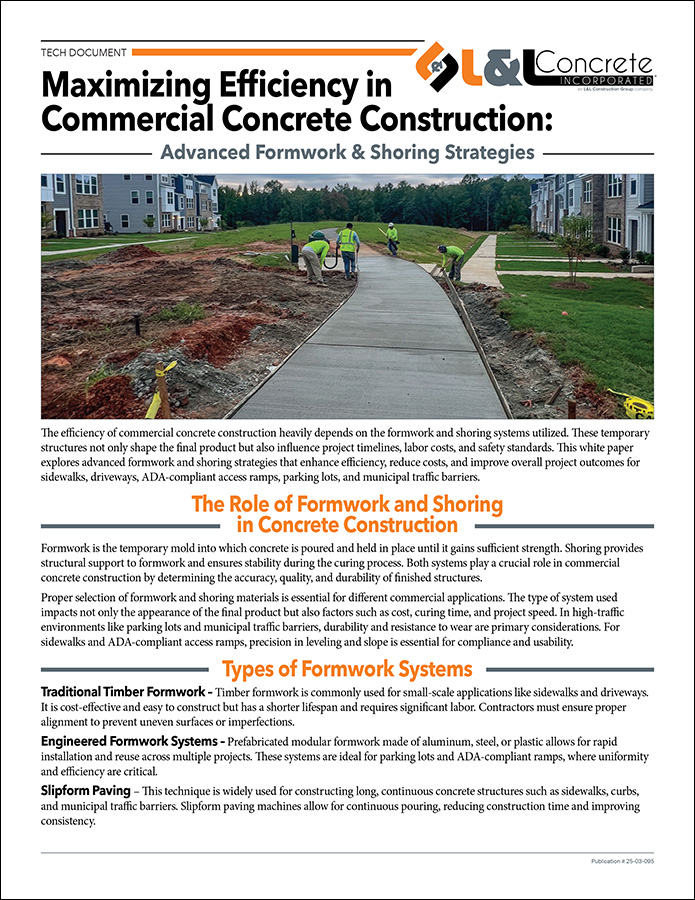Advanced Formwork & Shoring Strategies

The efficiency of commercial concrete construction heavily depends on the formwork and shoring systems utilized. These temporary structures not only shape the final product but also influence project timelines, labor costs, and safety standards. This white paper explores advanced formwork and shoring strategies that enhance efficiency, reduce costs, and improve overall project outcomes for sidewalks, driveways, ADA-compliant access ramps, parking lots, and municipal traffic barriers.
The Role of Formwork and Shoring in Concrete Construction
Formwork is the temporary mold into which concrete is poured and held in place until it gains sufficient strength. Shoring provides structural support to formwork and ensures stability during the curing process. Both systems play a crucial role in commercial concrete construction by determining the accuracy, quality, and durability of finished structures.
Proper selection of formwork and shoring materials is essential for different commercial applications. The type of system used impacts not only the appearance of the final product but also factors such as cost, curing time, and project speed. In high-traffic environments like parking lots and municipal traffic barriers, durability and resistance to wear are primary considerations. For sidewalks and ADA-compliant access ramps, precision in leveling and slope is essential for compliance and usability.

Types of Formwork Systems
Traditional Timber Formwork
Timber formwork is commonly used for small-scale applications like sidewalks and driveways. It is cost-effective and easy to construct but has a shorter lifespan and requires significant labor. Contractors must ensure proper alignment to prevent uneven surfaces or imperfections.
Engineered Formwork Systems
Prefabricated modular formwork made of aluminum, steel, or plastic allows for rapid installation and reuse across multiple projects. These systems are ideal for parking lots and ADA-compliant ramps, where uniformity and efficiency are critical.
Slipform Paving
This technique is widely used for constructing long, continuous concrete structures such as sidewalks, curbs, and municipal traffic barriers. Slipform paving machines allow for continuous pouring, reducing construction time and improving consistency.
Insulated Concrete Forms (ICFs)
Used in the construction of durable traffic barriers, ICFs enhance insulation and structural longevity. These forms remain in place after the concrete sets, providing additional protection against weathering and impact damage.
Shoring Techniques for Maximum Stability
Adjustable Steel Props and Frames
These are used to support formwork for driveways and ADA-compliant ramps, stability during the curing process. They are easy to adjust and can be reused for multiple projects.
Scaffold-Based Shoring
This technique is essential for projects involving sloped parking lots and ramps. Scaffolding enhanced support, particularly in areas where changes in elevation require additional bracing.
Flying Shoring Systems
These systems are used for large-scale municipal concrete projects, such as multi-level parking and reinforced traffic barriers. They allow for quick repositioning and adaptability to complex structural designs.
Cost-Saving & Sustainable Formwork Solutions
Reusable & Recyclable Materials
Modern formwork materials, such as aluminum and plastic, can be reused across projects, reducing overall material costs. This is particularly beneficial for recurring projects such as parking lot expansions municipal sidewalk installations.
Eco-Friendly Formwork Innovations
Bamboo and fiber-reinforced plastic formwork offer sustainable alternatives to traditional materials. These options reduce environmental impact while maintaining durability for commercial applications.
Maximizing Reusability
Implementing best practices for cleaning, storage, and maintenance of formwork extends its lifespan. Using formwork oils and protective coatings can further enhance reusability, lowering long-term costs.
Safety Best Practices in Formwork & Shoring
OSHA Compliance and Industry Standards
Adhering to safety regulations ensures that formwork and shoring meet stability and load-bearing requirements, minimizing the risk of accidents.
Preventing Formwork Failures
Proper bracing, load distribution, and regular inspections help prevent collapses areas like ADA-compliant ramps and parking lots.
Training and Certification
Ensuring crews are properly trained in formwork installation techniques improves efficiency and reduces on-site errors. Certification programs provide workers with the necessary expertise to maintain safety and quality standards.
Conclusion
Adopting advanced formwork and shoring strategies can significantly improve efficiency, reduce costs, and enhance job site safety in commercial concrete construction. By leveraging modern materials, automation, and best practices, contractors can optimize their processes and deliver high-quality sidewalks, driveways, ADA-compliant access ramps, parking lots, and municipal traffic barriers with minimal delays. Investing in advanced formwork and shoring solutions not only enhances project performance but also contributes to long-term sustainability and safety in the industry.
